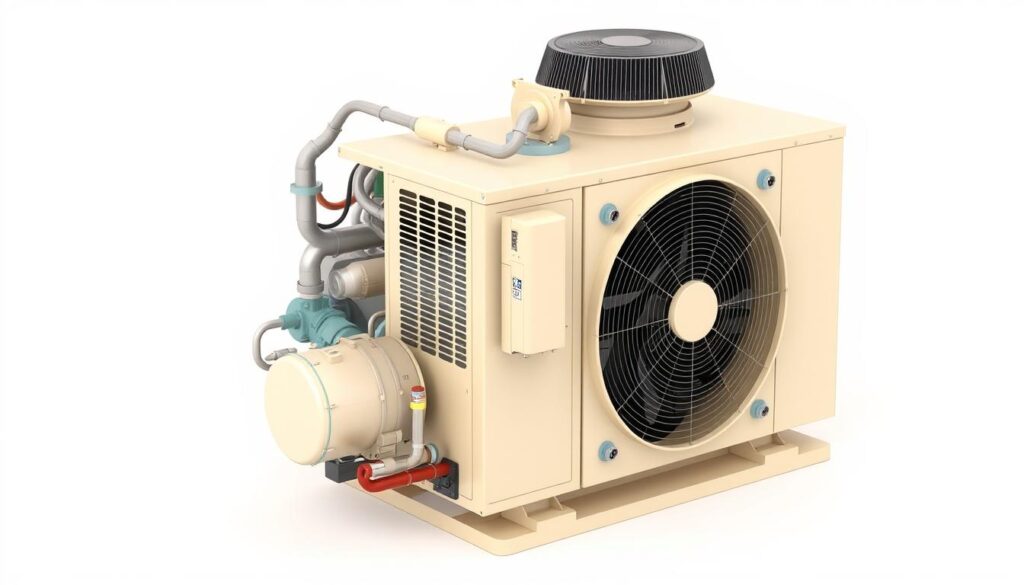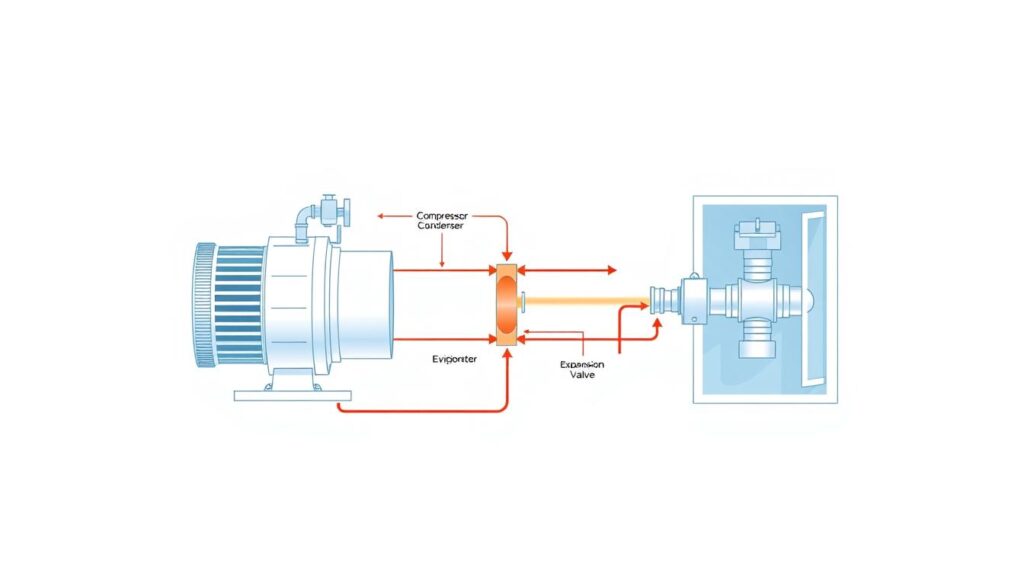Affiliate Disclosure
HVAC Guide Guys is a participant in the Amazon Services LLC Associates Program, an affiliate advertising program designed to provide a means for sites to earn advertising fees by advertising and linking to Amazon.
How HVAC AC Works? Ever wondered what keeps your home comfy in hot summers and cold winters? It’s not magic—it’s your HVAC system working hard to keep things just right.

An HVAC system is more than a machine. It’s the secret keeper of your home’s comfort. With 95% of U.S. homes using heating and cooling, knowing how your air conditioning works can help you save energy.
Modern HVAC systems are complex. They control temperature, humidity, and air quality. From central air conditioning in 46% of U.S. homes to advanced heat pump technologies, they make your home a cozy haven.
Key Takeaways
- HVAC systems control temperature, humidity, and air quality
- 95% of U.S. homes use heating and cooling technology
- Central air conditioning is used in nearly half of U.S. households
- Understanding your HVAC system can lead to energy savings
- Proper maintenance extends system lifespan
Table of Contents
Understanding HVAC Systems: The Basics
Your home’s comfort relies on a complex system of heating, ventilation, and air conditioning. HVAC systems keep your indoor climate perfect for you and your family.
An HVAC system is more than just an air conditioner. It’s a complex network that controls temperature, humidity, and air quality. Let’s dive into the basics of these systems.
Definition and Purpose of HVAC
An HVAC system does three main things:
- Heats your home in the cold months
- Cools it when it gets hot
- Keeps the air circulating and clean
“A well-designed HVAC system is the key to year-round comfort and energy efficiency.”
The Role of Ventilation in Your Home
Ventilation is key in your air conditioning plan. It does more than just move air. Good ventilation:
- Removes stale air
- Filters out dust and pollutants
- Controls moisture levels
- Prevents air quality problems
Why HVAC Systems Matter for Indoor Comfort
Did you know HVAC systems use 40% to 50% of your home’s energy? Getting an efficient system is smart for energy and comfort.
Today’s HVAC tech offers big benefits:
- Can save up to 30% energy with ductless systems
- Improves air quality by filtering 95% of particles
- Keeps the temperature steady
- Reduces indoor pollution
Explore Our HVAC Shop
Looking for top-rated HVAC tools, parts, and accessories? Visit our shop and find the perfect solution for your needs.
Visit the ShopEssential Components of an HVAC System
Your HVAC system is made up of many parts working together. These parts help keep your home comfortable. Knowing about them shows how your cooling system works and why it needs regular checks.
The main parts of an HVAC system are key to controlling temperature and air quality:
- Thermostat: The brain of your system, controlling temperature settings
- Compressor: Often called the “heart” of the HVAC system
- Condenser: Responsible for releasing heat outdoors
- Evaporator: Absorbs indoor heat and initiates the cooling process
- Refrigerant lines: Circulate cooling agents through the system
“The compressor is the critical component that drives the entire cooling cycle.” – HVAC Engineering Insights
Each part has a special job in your HVAC system. The compressor, in the outdoor unit, makes refrigerant temperature and pressure go up. This is key for moving heat from inside to outside.
| Component | Primary Function | Location |
|---|---|---|
| Compressor | Compress refrigerant | Outdoor unit |
| Condenser | Release absorbed heat | Outdoor unit |
| Evaporator | Absorb indoor heat | Indoor air handler |
Keeping these parts in good shape is important. Experts say to get your HVAC checked every year. This keeps it working well and stops big problems.
How HVAC AC Works: The Complete Process
Learning about your air conditioning system can make you appreciate how it keeps your home cool. The HVAC AC system is a complex system that turns warm air into cool air inside your home.
The refrigeration cycle is at the core of how HVAC AC works. It involves several steps to remove heat from your home:
The Refrigeration Cycle Explained
- Refrigerant absorbs heat from indoor air
- Compressor pressurizes the refrigerant
- Heat is released outside through the condenser
- Cooled refrigerant returns to the indoor unit
“Nearly 90% of American homes use some form of air conditioning, making the cooling process a critical comfort technology.”
Air Distribution Process
Your air conditioning system has many parts to spread cool air around your home. The indoor air handler and outdoor condenser work together to keep your home at the right temperature.
| Component | Function |
|---|---|
| Evaporator Coil | Absorbs indoor heat using refrigerant |
| Compressor | Moves and pressurizes refrigerant |
| Condenser Coil | Releases absorbed heat to the outside |
Temperature Control Mechanisms
The cooling process is controlled by your thermostat. It acts as the brain of your HVAC system. It checks the indoor temperature and tells the AC to cool or stop cooling as needed. This ensures your home stays just right.
By understanding how HVAC AC works, you can see the advanced technology that keeps you cool when it’s hottest.
Explore Our HVAC Shop
Looking for top-rated HVAC tools, parts, and accessories? Visit our shop and find the perfect solution for your needs.
Visit the ShopThe Cooling Cycle: From Warm to Cold Air
Your home’s air conditioning system turns warm air into cool air. This amazing change starts with the refrigerant, a key chemical in heat transfer.

The cooling cycle begins when warm air meets the cold evaporator coils. Here, the refrigerant takes heat from the air, changing its temperature. As it evaporates, it removes heat and humidity, leaving air cooler and more comfortable.
“Air conditioning doesn’t create cold air – it removes heat from your living space”
- Refrigerant enters the evaporator as a low-pressure liquid
- Warm air passes over the cold evaporator coils
- Heat is absorbed, causing the refrigerant to change from liquid to gas
- Cooled air is circulated back into your home
The cooling process’s success depends on several factors. The evaporator coils need the right temperature. The refrigerant must go through different states to absorb heat well.
| Cooling Stage | Key Action | Temperature Change |
|---|---|---|
| Evaporation | Heat Absorption | Warm to Cool |
| Compression | Pressure Increase | Low to High |
| Condensation | Heat Release | Hot to Cooler |
Understanding this cycle helps you appreciate the complex technology working silently to keep your home comfortable during hot summer days.
Key Parts of Your AC System
Knowing the main parts of your air conditioning system helps you see how it keeps your home cool. Each part has a special job in controlling the temperature.
Compressor and Condenser Unit: The Heart of Cooling
The compressor is the core of your AC system. It makes the refrigerant gas high-pressure. This part works with the condenser unit to remove heat from your home.
- Compresses refrigerant gas to high pressure
- Transfers heat from indoor to outdoor environment
- Enables the refrigeration cycle
Evaporator Coils and Blower: Cooling in Action
The air handling unit has the evaporator coils. They take in indoor heat. As warm air hits these coils, the refrigerant gas turns into a liquid, cooling the air. The blower then spreads this cool air around your home.
“The evaporator coil is where the magic of cooling happens, transforming warm air into a refreshing breeze.”
Thermostat and Control Systems: Precision Temperature Management
Smart thermostats have changed how we cool our homes. They use geofencing to adjust the temperature based on your phone’s location. This makes your home comfortable and saves energy.
- Monitors indoor temperature
- Triggers cooling cycles
- Enables energy-saving modes
Every part of your AC system works together to keep your home cool. Regular upkeep keeps these parts running well.
Explore Our HVAC Shop
Looking for top-rated HVAC tools, parts, and accessories? Visit our shop and find the perfect solution for your needs.
Visit the ShopTypes of HVAC Systems for Your Home
Choosing the right HVAC system can make your home more comfortable and energy-efficient. There are many options, and knowing about them helps you decide.
In the United States, there are several HVAC systems for different homes. Let’s look at the most popular ones:
- Central Air Conditioning Split Systems
- Hybrid Split Systems
- Ductless Mini-Split Systems
- Packaged HVAC Systems
- Geothermal HVAC Systems
Each HVAC system has its own benefits for your home. Central air conditioning split systems are the most common. They cool your whole home through ducts. These systems cost between $3,000 and $12,000, depending on your home’s size and needs.
“The right HVAC system can reduce your energy consumption by up to 30%” – HVAC Energy Efficiency Report
If you have limited space or need specific cooling, ductless mini-split systems are great. They can be up to 30% more energy-efficient than traditional systems. This makes them a good choice for today’s homeowners.
| HVAC System Type | Energy Efficiency | Average Installation Cost |
|---|---|---|
| Central Split System | 15-20% efficiency improvement | $3,000 – $12,000 |
| Ductless Mini-Split | 30% more efficient | $3,000 – $6,000 |
| Geothermal Heat Pump | 25-50% energy cost reduction | $10,000 – $25,000 |
Geothermal HVAC systems are the most energy-efficient. They can cut energy costs by 25-50%. Though they cost a lot to install, they save money in the long run.
Energy Efficiency and Performance Factors
Knowing how efficient your HVAC system is can save you a lot of money. It also makes your home more comfortable. Modern air conditioning is great at cutting down energy use while keeping your home cool.
There are several important things to look at when checking your air conditioner’s performance. The Seasonal Energy Efficiency Ratio (SEER) is a key number for measuring how well it cools.
SEER Ratings Explained
SEER ratings are like miles per gallon for air conditioners. The lowest SEER is 13, and higher numbers mean it uses less energy. Newer air conditioners can save up to 40% on your energy bills compared to old ones.
- Minimum SEER rating: 13-14
- Higher SEER = Lower energy costs
- Potential savings: Up to 40% on energy bills
Optimizing System Operation
Here are some ways to make your HVAC system work better:
- Keep the temperature between 76-78 degrees
- Get annual maintenance
- Change or clean air filters often
- Make sure it’s installed right
“A well-maintained HVAC system is the key to energy efficiency and long-term savings.”
| Efficiency Factor | Impact on Energy Consumption |
|---|---|
| Dirty Filters | Increases power consumption by up to 15% |
| Mismatched Units | Reduces efficiency by 30% |
| Regular Maintenance | Reduces energy costs significantly |
By learning about SEER ratings and using smart tips, you can make your HVAC system more energy-efficient. Regular maintenance and new technologies can help your air conditioner work better.
Explore Our HVAC Shop
Looking for top-rated HVAC tools, parts, and accessories? Visit our shop and find the perfect solution for your needs.
Visit the ShopMaintenance Requirements for HVAC Systems

Keeping your air conditioning system in top shape is key for home comfort and energy savings. Regular maintenance stops costly breakdowns and makes your HVAC last longer.
“Preventive maintenance is the key to a reliable and efficient HVAC system”
Your HVAC system needs regular care to work its best. Here are the most important maintenance tasks:
- Monthly air filter checks and replacements
- Seasonal professional inspections
- Cleaning condenser and evaporator coils
- Checking refrigerant levels
- Inspecting ductwork for leaks
Ignoring your air conditioning maintenance can cost a lot. Dirt and poor maintenance are top causes of HVAC system failures.
| Maintenance Task | Frequency | Estimated Cost |
|---|---|---|
| Air Filter Replacement | Monthly | $10-$30 |
| Professional HVAC Tune-up | Annually | $150-$300 |
| Duct Cleaning | Every 3-5 Years | $300-$700 |
Regular maintenance saves you almost $140 a year. It can also make your HVAC system last up to 25 years. A well-maintained system is an efficient one!
Modern HVAC Technologies and Innovations
The HVAC world is changing fast, with new technologies that change how we keep our homes comfortable and save energy. Today’s air conditioning does more than just cool your space. It makes your home smart and responsive.
Smart technologies are changing the HVAC world, giving us more control and efficiency. Let’s look at the latest innovations:
Smart HVAC Controls
Modern air conditioning systems now use advanced tech for a better user experience:
- Wi-Fi-enabled thermostats with smartphone app control
- Real-time energy consumption tracking
- Automated temperature adjustments
- Machine learning for personalized comfort
Energy-Saving Features
Today’s HVAC tech aims to save energy and boost efficiency:
| Technology | Energy Savings |
|---|---|
| Smart Thermostats | 10-15% reduction |
| Variable Speed Compressors | Up to 30% more efficient |
| Zoning Systems | 10-30% energy cost savings |
| IoT Integration | Up to 20% energy reduction |
“The future of HVAC is intelligent, efficient, and personalized.” – HVAC Technology Experts
New tech like predictive maintenance, advanced air purification, and IoT integration are making HVAC systems smarter. They adapt to your needs and save energy.
Explore Our HVAC Shop
Looking for top-rated HVAC tools, parts, and accessories? Visit our shop and find the perfect solution for your needs.
Visit the ShopCommon HVAC System Configurations
Knowing about different HVAC systems helps you pick the best air conditioning for your home. Each type has special benefits for different homes and climates.
Split systems are the most common, making up about 70% of installations. They have two parts: an outdoor unit and an indoor air handler.
- Central A/C Split Systems: Combine an outdoor condenser coil and compressor with an indoor air handler
- Heat Pump Split Systems: Can reverse refrigerant flow for both heating and cooling
- Hybrid Split Systems: Switch between gas and electric heating for maximum efficiency
Packaged units are a compact choice. They have all heating and cooling parts in one cabinet. They’re great for commercial places and small homes.
| System Type | Key Features | Best For |
|---|---|---|
| Split Systems | Separate indoor and outdoor units | Most residential homes |
| Ductless Systems | No ductwork required | Homes with limited space |
| Packaged Units | All-in-one system | Small homes, commercial spaces |
Pro Tip: Ductless mini-split systems have increased by over 50% in residential installations, providing flexible and energy-efficient air conditioning solutions.
Choosing the right HVAC system can save you up to 30% on heating and cooling costs. Think about your home’s size, climate, and energy goals when picking.
Conclusion
Knowing how HVAC AC works is key to a comfy and efficient home. Your air conditioner does more than cool—it controls temperature, humidity, and comfort. Understanding your HVAC system helps you make smart choices about upkeep, energy use, and upgrades.
Energy efficiency is at the heart of today’s air conditioning. Modern HVAC systems can cut energy use by up to 30%, saving you money on bills. Keeping your AC unit clean, like the evaporator and condenser coils, boosts performance and extends its life. This care prevents sudden failures and keeps your home cool.
Knowing how HVAC AC works lets you make your home more comfortable. Whether you have central air or a window unit, understanding how it works helps you get the most out of it. Don’t forget, getting your AC checked by a pro once a year keeps it running well and avoids expensive fixes.
As technology gets better, HVAC systems are getting smarter and greener. By staying up-to-date and caring for your air conditioner, you’ll enjoy better comfort, lower bills, and help the planet.

